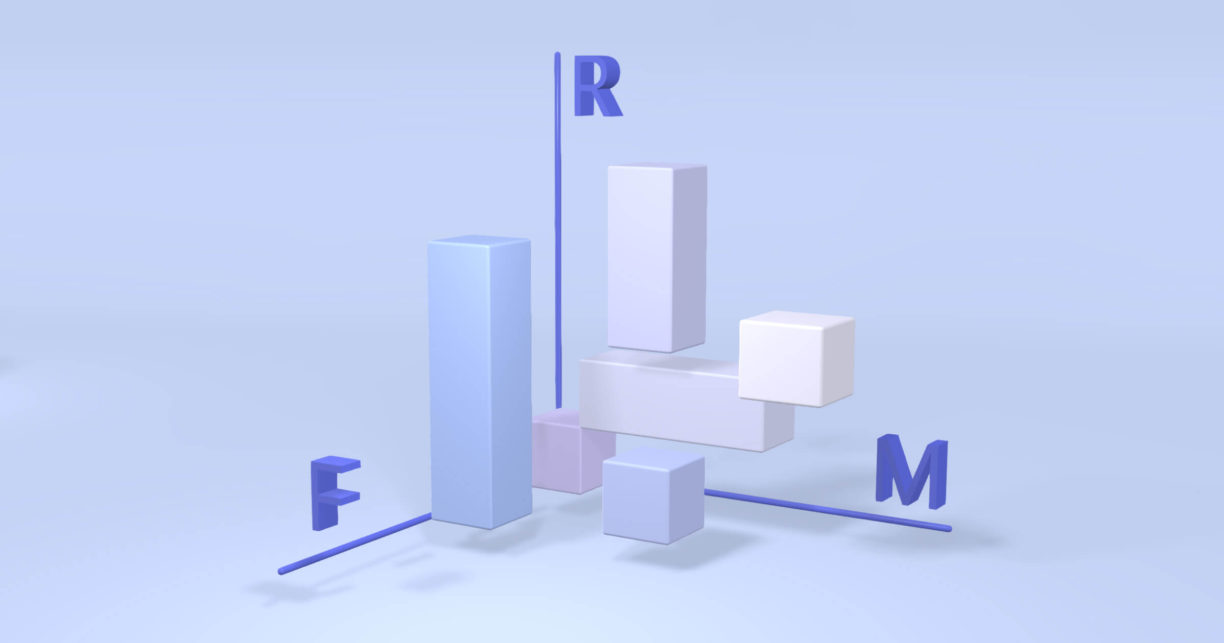RFM Segmentation stands for Recency, Frequency and Money – or profit. These acronyms refer to where a customer stands on the spectrum of buying habits and loyalty. These ideas may seem familiar if you have ever experienced them while shopping in a store, booking a flight online, or ordering a product online. Each of these moments is an opportunity to extend your business into the more profitable territory by understanding what makes each potential customer unique, and tailoring offers to their individual needs.
55% of customers want to use rewards across multiple brands. The easiest way for growing brands to start such a loyalty program is Monetha - Loyalty & Rewards. Ready to try?
What is the RFM Segmentation and How Does It Work?
In the marketing world, recency, frequency, and monetary (RFM) segmentation is a data-driven approach to grouping customers into segments based on their transactional behaviors.
Customer data is segmented based on these three criteria and ranked from high to low. Accordingly, each customer segment is assigned a score of 1–4 for recency (1 being the most recent), frequency (1 being the highest), and for monetary value (1 being the highest). This means that any given customer is assigned a score from 1–64 that represents their “RFM value.
The higher the RFM score a customer has, the more valuable they are to your business.
Not only does the RFM model help marketers understand their customers better and optimize business strategies, but it’s also an effective way to create personalized customer experiences and make loyal customers out of those who are on the fence.
With RFM segmentation, your business can create distinct segments of your customers based on these three variables and also use these segments to develop strategies for targeting each individual group of customers with more personalized marketing material and promotions.
Examples
This kind of segmentation is a fairly simple and straightforward approach to dividing your customers into groups based on their engagement. It’s easy to implement, and it works well because it’s so simple. You don’t have to worry about complex algorithms or data sets—just three numbers (or ratings) for each customer: how recently they purchased something from you, how frequently they buy from you, and how much money they spend.
You can then assign a score (e.g., a number from 1-10) to each of these measures for each customer. Then, you can combine those scores into one overall score for each customer—for instance, by adding the three numbers together—and then sort your customers from the highest overall score to the lowest.
The ones who spend the most with you, who buy the most often, and who buy the most recently are your best customers—so this is where you should focus your marketing efforts. Your lowest-scoring customers are those who are at risk of churning: they haven’t bought anything recently or they don’t buy very often or they only buy small amounts when they do, so you might want to think about trying to engage them more effectively.
Now that you understand the basics, let’s dive into each aspect:
What are Recency, Frequency and Monetary?
Recency
Recency (RFM) segmentation is a method of segmenting customers based on how recently they have made a purchase and how frequently they tend to buy. It’s often used in tandem with monetary segmentation, which assigns customers to segments based on their average order value (AOV).
This type of segmentation has many benefits for eCommerce companies. First, it allows you to separate your customers into groups that are likely to behave similarly in the future. For example, if you know that customers who have placed an order within the last 30 days are more likely to place another order soon than those who haven’t ordered in the last 90 days, you can use this knowledge to fine-tune your marketing efforts and put more resources toward people who are most likely to spend again.
The steps involved in recency segmentation include:
Choose the most recent transaction date for each customer
Count the number of days between today and the transaction date for each customer
Group customers into recency segments, such as “recent,” “medium,” and “old”
To implement recency segmentation, companies should first look at their data set and determine what period of time they consider “recent.” The period of time they choose will be an important factor in how they identify customers with high recency scores.
Frequency
Frequency segmentation is used to group customers based on how often they purchase, how long it’s been since they made their last purchase, and the total amount they’ve spent. These three variables are considered independently of one another, and customers can be placed into different groups depending on how highly or lowly they score in each category.
Ask yourself:
How often does the average customer make a purchase?
How many times does the average customer visit your website?
How frequently do active customers engage with your brand on social media?
This method is often used in retail or eCommerce contexts, where there is a lot of data about purchase behavior and transaction history available. This kind of segmentation is best for companies that have a large customer base and a lot of data about each customer’s purchase history.
Monetary
Monetary segmentation is often considered the most important RFM factor because it indicates how much a customer has spent with your brand over a period of time.
It’s a good idea to treat big spenders differently than those who have only purchased one or two items in the past year. When you look at monetary divided by frequency, you’ll find the average purchase amount – an important secondary factor to consider when segmenting customers.
If the customers with the highest monetary value are also the most frequent customers, they’re likely loyal to your brand. On the other hand, if you have less frequent but high-value customers, they may be more price-conscious and will generally be harder to retain. It may require special efforts or incentives to bring these customers back more often.
Why is RFM Segmentation Important?
RFM Segmentation is important for separating out your best customers from the ones who are less profitable or engaged. This can be especially important for large businesses, where you may have a huge customer base and need to know how to target the most valuable customers in the most cost-effective way.
This type of segmentation allows you to do this by ranking customers according to their Recency, Frequency, and Monetary value so that you can focus on the ones who are most likely to buy a lot of your products at a high price point.
How to Calculate It
RFM is calculated by analyzing the past behaviors of your customers and assigning them a score for each metric; these scores are then combined to give you a final RFM score for each customer.
To calculate recency, you should look at how recently each customer has made a purchase from your company. This can be measured in days, weeks, or months since their last purchase. Customers who have made a purchase more recently will receive a higher recency score than those who made their most recent purchase long ago.
Frequency is determined by looking at how many purchases each customer has made in the same time period that was used to calculate recency—the more purchases they’ve made in that time period, the higher their frequency score will be.
And monetary value is based on how much money each customer has spent on your products during that same time period of time.
What is RFM Analysis?
Before going into how you’re going to do the segmentation using the RFM model, it’s important to understand the basics of RFM analysis, and that’s what we are briefly tackling in this part of the text.
RFM Analysis is a useful way to analyze your customer base. It stands for Recency, Frequency, and Monetary value. It’s a way to segment customers according to their purchase history. Its ultimate goal is to identify your best customers so you can market them more effectively and increase their lifetime value.
This analysis works by identifying the top 10%, 20%, or 30% of customers who have spent the most money with your company over time. The ideal customers are those who spend the most money, who buy the most often, and who bought most recently. Those are your best customers
By identifying these individuals, you can market more effectively by focusing on what works for them. You can adjust your messaging and offers to be relevant to these key segments of your customer base so that you can increase their lifetime value and grow future sales.
How to Perform It?
To perform an RFM analysis, you need to first find the customers you want to analyze. Then you should assign each customer a score from 1-to 5 in the following categories: recency, frequency, and monetary value. One is the lowest possible score while five is the highest possible score.
Customers that have bought from you recently are given high scores while customers that have not bought from you recently are given low scores. Similarly, customers who purchase regularly are given high scores while those who only purchase every once in a while are given low scores. Customers who spend a lot of money at your store are given high scores while those who spend little money at your store are given low scores.
Once a customer has been assigned a score for each category, you can then segment them into segments based on their total score (the sum of their recency, frequency, and monetary value scores). Those with higher total scores belong in better segments than those with lower total scores
How Do You Segment Your Audience Using It?
First, you’ll need to create a table that will help you analyze customer data according to their recency, frequency, and monetary value. Start with the date of their most recent purchase. Once you’ve decided your definition of recent, set a date that’s far enough in the past that you can be sure any purchases made before it would fall into the “old” bucket of customers.
Next, take a look at how often your customers are purchasing from you. How many times do they made a purchase of the products you are offering? If there’s variation in this number across your customers, create different segments for different levels of frequency.
Finally, take a look at how much money your customers spend on each purchase or over time (their monetary value). Again, this may vary across your customers—which means you should create different segments based on what percentage of your sales each group represents.
Its Limitations – What to Avoid?
RFM Analysis is a powerful way to segment your customers and identify those most likely to buy from you again. But it has its limits, which you should be aware of to avoid misunderstandings or poor decision-making.
For example, if a high recency score is based on a single transaction, that customer may not actually be very close to making another purchase. The value of recency only increases as a customer makes more purchases—in other words, the more recent transactions there are, the more accurate the recency score.
Similarly, if recency is measured in “weeks since the last transaction,” it may be hard to compare customers with different purchasing patterns. If customers generally shop every six months, and Customer A purchased two weeks ago and Customer B purchased four weeks ago, they would both have the same score—and that score wouldn’t tell us much about their likelihood of making another purchase.
Conclusion
Ultimately, RFM is one of the most effective marketing tactics to implement if your goal is converting more leads into actual customers.
Knowing how to set up these small Recency, Frequency and Monetary campaigns will make all the difference in getting more sales and improving your bottom line. By doing this, you are moving towards the ultimate goal of any marketer — which is, of course, to turn more heads towards your business. But only you can take action on it and put such plans into effect.
Using RFM segmentation, you can look at the various customer data available to you and visually see how the different segments can be subdivided. This is important for creating marketing strategies in regard to products.
Create always up-to-date RFM based custom audiences and mailing lists with Verfacto.
FAQs
What is the RFM model?
The RFM model is a marketing model for identifying customers who are more likely to respond to a new offering, based on their past purchasing patterns.
What Does RFM Mean in CRM?
The RFM model is used in customer relationship management (CRM) systems to determine the quality of relationships with customers. If a customer spends a lot of money and does so frequently, they are considered to have a high-quality relationship with the company and should be considered valuable. Conversely, if a customer has made few or no purchases recently, they are not seen as having as high-quality a relationship with the company and are considered less valuable.
Is RFM effective for small and medium-sized businesses?
Yes, RFM is a great tool for small and medium-sized businesses because it helps them use data to target their campaigns and provides a strong framework to build strategies around.
Its power comes from its ability to help businesses make sense of their customer data, segment customers into groups, and then create more effective campaign strategies based on those segments. A business can organize its customers based on spending, recency, and frequency, which helps them see what kind of customer activity is happening in their business.
The reason RFM is so useful for planning marketing campaigns is that it allows you to see which customers are most likely to respond positively to your campaign. This means you’re not wasting valuable time and resources on marketing efforts that won’t pay off; instead, you can focus on those customers who are most likely to respond positively.




